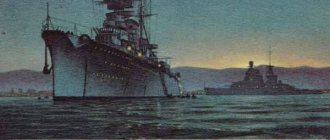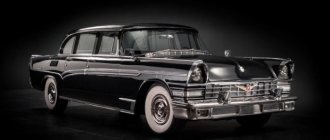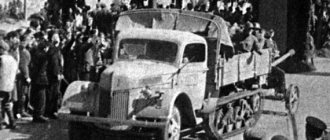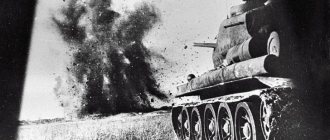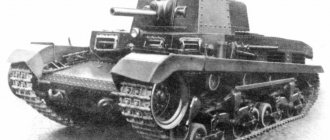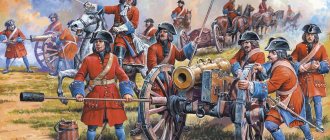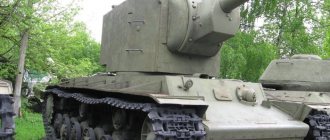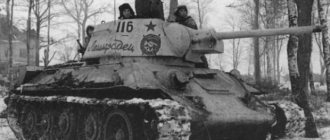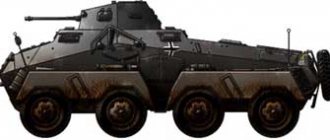One of the symbols of World War II for the Soviet people was the legendary “Katyusha”. This multiple rocket launcher provided powerful support in the liberation battles, which is why it is still associated with victory.
Serial production of these weapons began from the first day of the German occupation, so they lasted throughout the war. They tried to install these artillery systems on the chassis of tractors, tanks, and cars. The most successful were two truck options.
General information/history of ZIS 6
| ZIS-6 | |||||||||||||||||||||||
| Total information | |||||||||||||||||||||||
| Years of production | 1933—1941 | ||||||||||||||||||||||
| Assembly | ZIS (Moscow, USSR) | ||||||||||||||||||||||
| Design | |||||||||||||||||||||||
| Engine | |||||||||||||||||||||||
| Transmission | |||||||||||||||||||||||
| ZIS-6 - Soviet three-axle (6 × 4) 4-ton off-road truck with dual-slope rear axles. Created on the basis of the mass-produced national economic truck ZIS-5 (4 × 2). The second most popular “three-wheeler” (after GAZ-AAA) in the Red Army in the 30s and in the initial period of the Great Patriotic War. From December 1933 to October 15, 1941, the Automobile Plant named after I.V. Stalin produced 21,239 units. ZIS-6 [1].
| |||||||||||||||||||||||
Trucks and special vehicles | USSR
Flatbed truck GAZ-AA (one and a half truck)
GAZ-AA with quad M-4 anti-aircraft machine gun mount
Gasoline tanker BZ-38 based on GAZ-AA
Gasoline tanker BZ-42 based on GAZ-AA
The car was produced since 1932 by the Nizhny Novgorod (later Gorky) Automobile Plant. It was a licensed copy of a 1929 Ford AA truck. Until 1934, the cabin was made of wood and pressed cardboard, and then was replaced by a metal one with a leatherette roof. In addition to GAZ, the car was produced at the Moscow KIM plant (1933-1939) and the Rostov Auto Assembly Plant (1939-1941). The machine's engine could also run on naphtha, kerosene and industrial lubricating oils. A number of modifications were created on the car chassis: radio stations and radars, auto repair shops and tankers, air defense installations and ambulances. A total of 829.8 thousand vehicles were produced, and as of June 20, 1941, there were 150 thousand trucks in the Red Army alone. Performance characteristics of the vehicle: length – 5.3 m; width – 2 m; height – 1.9 m; ground clearance - 200 mm; curb weight – 1.8 t; total weight – 3.3 t; maximum speed – 70 km/h; load capacity – 1.5 t; engine type - "GAZ-A" (40 hp), later - "GAZ-MM" (50 hp); transmission – 4-speed manual gearbox; fuel consumption – 19.5 l/100 km; Power reserve – 250 km.
GAZ-MM with 25-mm automatic anti-aircraft gun 72-K
Flatbed truck GAZ-MM-V
The GAZ-MM car was a modernized version of the GAZ-AA without external differences, which was produced since 1938. It differed from its predecessor in a 50-horsepower engine, reinforced suspension, new steering and driveshaft. A modification is known under the designation “GAZ-MM-V” (GAZ-MM-13) - a simplified version of wartime (1942-1945). It had two types of cabins: 1942-1943 model. with a canvas roof and canvas flaps instead of doors and a 1944 model with wooden cladding and doors. On the ’42 truck, the fenders were made of flexible low-grade (roofing) iron. The muffler, bumpers and front brakes were missing. The headlight and wiper were installed only on the driver's side. The platform was equipped with a rear hinged side. Performance characteristics of the vehicle: length – 5.3 m; width – 2 m; height – 1.9 m; ground clearance - 200 mm; curb weight – 1.8 t; load capacity – 1.5 t; engine type - GAZ-M; engine power – 50 hp; maximum speed – 70 km/h; fuel consumption – 19.5 l/100 km; Fuel tank capacity - 40 l.
Bus GAZ-03-30
The bus was produced since 1933 on the basis of GAZ-AA/GAZ-MM, as a model for civilian use. During the war, the car was used for military purposes, incl. It was also used as a sanitary one. The body had a wooden frame with wood-metal sheathing. The outside side walls were lined with iron sheets 1 mm thick. The body had 3 doors: the front side right door was intended for passengers to enter and exit and was equipped with a controller in the form of a long lever with a handle, which allowed the driver to open and close the door as needed; The front left side door was the driver's door, and the rear was the spare door. The body had 9 windows, 6 of which could be opened. The bus had front and rear bumpers. Inside, the ceiling and walls were covered with leatherette, and the cushions and backs of the seats for the driver and passengers were also upholstered with it. A total of 18.6 thousand cars were produced. Performance characteristics of the vehicle: length – 5.3 m; width – 2.1 m; height – 2.5 m; wheelbase - 3.3 m; curb weight – 2.3 t; ground clearance - 200 mm; engine – 4-cylinder, in-line, carburetor; engine power – 50 hp; maximum speed – 65 km/h; fuel consumption – 20.5 l/100 km; capacity – 17 people with driver; transmission – 5 gears (4 – forward, one – reverse); Fuel tank capacity - 40 l.
Ambulance vehicle GAZ-55 (M-55) pre-war production
Military ambulance GAZ-55 (M-55)
The car was developed on the basis of the GAZ-MM/GAZ-MM-V chassis and was produced since 1938 with the GAZ-M engine. It was equipped with extended springs and shock absorbers on the rear axle, a heater powered by exhaust gases, and a ventilation system. The room for the wounded was separated from the driver's cabin by a partition. The car could carry 4 lying on a stretcher and 2 sitting on folding seats or 2 lying and 5 sitting or 10 sitting. At the beginning of the war, the car received angular wings and a simplified cabin and body. Instead of two headlights, it was equipped with only one. In total, more than 9,130 vehicles were produced before the end of the war. Vehicle performance characteristics: length – 5.4 m; width – 2 m; height – 2.3 m; ground clearance - 200 mm; wheelbase - 3.3 m; curb weight - 2.4 t; engine - 4-cylinder carburetor; engine power - 50 hp transmission – 4-speed gearbox; maximum speed - 70 km/h.
Aviation starter AS-1 based on GAZ-AA
The machine was produced since 1932 and was intended to start the engines of light propeller-driven aircraft. Launch was accomplished by grabbing the aircraft's propeller and turning the aircraft engine's crankshaft through a tubular structure with two drive shafts. Behind the cab there was a vertical cabinet with braces and a shaft that received rotation from the car's transfer case. Performance characteristics of the vehicle: starter speed – 1110-1300 rpm; The horizontal height of the trunk is 2.9 m.
Flatbed truck GAZ-AAA
GAZ-AAA with removable tracks
Charging station AES-3 based on GAZ-AAA
The car was produced in 1934-1943. and was a three-axle modification of the two-axle GAZ-AA/GAZ-MM truck, where the rear drive axle was replaced by a two-axle bogie with a balanced axle suspension on 4 longitudinal semi-elliptical springs, worm final drives and a 2-stage reduction gearbox in the transmission. Until 1937, the GAZ-AA engine was installed, after which the GAZ-MM engine was installed. The car was intended for transporting troops and cargo. In addition, on its basis the following were mass-produced: the GAZ-05-193 headquarters bus; armored vehicles "BA-6", "BA-10A", "BA-10M", "BA-27M", "BAI-M" and "BAI-3M"; rocket mortar "BM-8-48" (Katyusha); chemical combat vehicle "BKhM-1"; "SU-12" - self-propelled gun with a 76.2 mm cannon; "ZSU 61-K" - 37-mm automatic anti-aircraft gun; searchlight anti-aircraft installation "PO-15-8"; Air target detection radar "RUS-2" (Redut) and "RUS-2s" (Pegmatite); gas stations and repair shops "PARM". A total of 37.4 thousand cars were produced.
Performance characteristics of the vehicle: length – 5.3 m; width and height – 2 m; ground clearance – 230 mm; curb weight – 2.5 t; wheel formula – 6x4; maximum speed – 60/65 km/h; load capacity – 1.5-2 t; engine – 4-cylinder, in-line, carburetor; engine power "GAZ-A" - 40 hp, "GAZ-MM" - 50 hp; transmission – 10 gears (8 forward, 2 reverse); fuel tank capacity – 45 l, additional – 60 l; fuel consumption – 25 l/100 km; Power reserve – 100 km; number of seats in the cabin – 2.
Staff bus GAZ-05-193
The bus is based on the three-axle chassis of the GAZ-AAA truck and the body of the 17-seater GAZ-03-30 bus. It was produced in 1941-1945. At the end of 1941, the car received simplified wings and only one headlight. The bumpers were also eliminated. The car's interior was equipped with a heating system (heater) and was equipped with two spare wheels. In the body, two four-seater benches were installed along the sides, a table in the middle, and cabinets for storing papers and maps in the corners of the body. In total, about 2 thousand cars were produced. Performance characteristics of the bus: length – 5.3 m; width – 2.1 m; height – 2.6 m; ground clearance – 230 mm; curb weight – 3.1 t; maximum speed – 65 km/h; engine – 4-cylinder, carburetor, “GAZ-M”; power – 50 hp; wheel formula – 6x4; transmission – 5 speeds (4 forward and one reverse); maximum speed – 65 km/h; Power reserve – 150 km; capacity – 9 people.
Half-track vehicle GAZ-60
The car was produced in 1938-1940. The basis of the propulsion unit was a rubber track 390 mm wide. Transmission to the front and rear drive rollers of each side was carried out from the rear drive axle by two chains. The vehicle was used to deliver cargo and personnel, tow light guns and install anti-aircraft machine guns. A total of 1,134 vehicles were produced. Performance characteristics of the vehicle: length – 5.3 m; width – 2.4 m; height – 2.1 m; curb weight - 3.4 tons; total weight – 4.7 t; ground clearance - 200 mm; load capacity – 1.2 t; engine – 4-cylinder GAZ-M; engine power - 50 l. With; transmission - 5 gears (4 - forward, one - reverse); maximum speed – 35 km/h; fuel tank capacity – 40 and 60 l; fuel consumption – 57 l/100 km; number of seats in the cabin – 2.
Half-track vehicle GAZ-65
The GAZ-65 was a half-track truck based on the GAZ-MM. A chain gear was fixedly installed between the twin rear wheels, from which the chain transmitted rotation to a drive sprocket suspended from the rear under the frame. It was connected to a fine-linked metal track. On the off-road, a caterpillar drive was used, and on the road the car moved on wheels - the caterpillar was removed, and the caterpillar carriage was fixed in the raised position. A total of 1,801 vehicles were produced, of which 8 were accepted into the Red Army, 24 were taken by military builders, 10 went to the NKVD, the rest were rejected, dismantled and delivered to the army as regular GAZ-MMs.
Gas generator car GAZ-42
The car was produced since 1939 on the basis of GAZ-AA or GAZ-MM. Both generator gas and gasoline could be used as fuel, to accommodate which the car was equipped with a fuel tank with a capacity of 40 liters. To compensate for the loss of power, the final drive ratio was increased from 6.6 to 7.5, and the compression ratio in the engine was increased from 4.6 to 6.2. A gas generator version of the coal-fired vehicle is known under the designation “GAZ-43”. A total of 33.8 thousand cars were produced. Performance characteristics of the vehicle: length – 5.3 m; width – 2 m; height – 1.9 m; ground clearance - 200 mm; curb weight – 1.8 t; maximum speed – 50 km/h; load capacity – 1.2 t; engine power - 35 - 38 hp; consumption of wooden chocks - 50-55 kg/100 km; gas generator startup time - 5 - 10 minutes, installation weight 400 kg; stock of chocks - 150 - 200 kg.
Gas-cylinder car GAZ-44
“GAZ-44” was a serial car that ran on gas fuel and was produced in 1939. The car was based on the “GAZ-MM” model. The supply of natural gas, compressed to 200 atmospheres, was stored in six cylinders weighing 65 kg each. They were located under the loading platform. Performance characteristics of the vehicle: length - 5.3 m; width – 2 m; height – 1.9 m; ground clearance - 200 mm; curb weight – 2.2 t; engine type – 4-cylinder; engine power – 42 hp; load capacity – 1.1 t; weight of cylinders and gas equipment – 420 kg; maximum speed - 65 km/h; power reserve - up to 300 km; fuel consumption - 20 m³ of methane/100 km.
Onboard vehicle ZIS-5
Staff bus based on ZiS-5
ZiS-5A with a special truss for transporting pontoons of the N-2P heavy floating fleet
The car was produced since 1933 on the AMO-3, UlZiS and UralZiS platforms. The ZIS-5 modification was produced in 1933-1941. The design of the machine is made on a spar frame, the cabin is rectangular, wooden, upholstered in tin. The car was not equipped with bumpers except for export models. The vehicle was equipped with standard universal platforms "ZiS-5A" or with high sides "ZiS-5U". The truck was exported to Afghanistan, Iraq, Iran, Spain, China, Latvia, Lithuania, Mongolia, Romania, Turkey and Estonia. Based on the ZiS-5, 19 modifications of vehicles were produced. A total of 571.2 thousand cars were produced, incl. during the war years - 325 thousand. Vehicle performance characteristics: length – 6 m; width – 2.2 m; height – 2.1 m; ground clearance – 250 mm; wheelbase - 3.8/4.4 m; wheel formula - 4x2; curb weight – 3.1 t, gross – 6.1 t; layout - front-engine, rear-wheel drive, engine type - 6-cylinder, carburetor ZiS-5; engine power – 73 – 85 hp; transmission – 4-speed gearbox; load capacity – 3 t; maximum speed – 60 km/h; tank volume – 60 l; Power reserve – 205 km; fuel consumption – 34 l/100 km; weight of towed cargo – 3.5 tons; number of seats in the cabin – 2.
Tanker based on ZiS-5V
Onboard vehicle ZiS – 5V
The ZiS-5V truck was a military, simplified version of the ZiS-5 and was produced since 1942 by (66.9 thousand produced during the war), UlZiS (10.4 thousand) and UralZiS ( 8.5 thousand). The car was 124 kg lighter than the prototype, had a cabin made of plywood and wood (lining). The sheathing boards were fastened with nails. The roof of the cabin was made of wooden slats, over which leatherette was stretched. It was equipped with wings made of simple flexible sheet metal. Brakes were installed only on the rear wheels, only the tailgate was folding, and the headlight remained alone on the left side. By the end of the war, the equipment was partially restored.
Anti-aircraft machine gun based on ZIS-5U
The car was a variant of the ZiS-5 and was intended to mount a 12.7 mm DShK machine gun or a 7.62 mm 4-M machine gun, for which a special turret was mounted in the body. In total, more than 12 thousand cars were manufactured. The combat crew consisted of 3 people. Installation weight – 460 kg, height – 2.3 m.
Onboard vehicle ZIS-6
BM-13 rocket launcher based on ZiS-6
BZ-35 gas tanker based on ZiS-6
Sound collection system ZT-5 based on ZiS-6
The three-axle vehicle was created on the basis of the ZiS-5 and was produced in 1933-1941. It had dual-pitch tires on the rear axles and a vacuum booster in the mechanical brake drive. In 1941, BM-13 and BM-8 (Katyusha) rocket launchers were installed on its chassis, ZiS-6 Lux buses were assembled, the BA-11 armored car, the RUS-2 radar, and a van were produced - radio station, mobile power station “AES-4”, anti-aircraft searchlight “PO-15-8”, sound detector “ZT-5”, truck crane “AK-3”. A total of 21.2 thousand cars were produced. Vehicle performance characteristics: length – 6.1 m; width – 2.3 m; height – 2.2 m; ground clearance under the rear axle – 275 mm, under the front axle – 295 mm; wheelbase - 3.4 m; curb weight – 4.2 t, gross weight – 8.2 t; load capacity – 4 t; wheel formula – 6x4; maximum speed – 55 km/h; engine type – 6-cylinder, in-line, carburetor, liquid cooling; engine power – 73 hp; transmission – 15 gears (9 forward, 6 reverse); tank volume – 105 l; fuel consumption – 40l/100 km; Power reserve – 260 km; number of seats in the body – 25.
Bus ZIS-8
The bus was produced on the extended ZIS-11 chassis in 1934-1936. The bus was also supplied to Turkey. A total of 547 vehicles were produced. Vehicle performance characteristics: length – 7 m; width – 2.3 m; height – 2.8 m; wheelbase - 4.4 m; wheel formula - 4x2; curb weight – 4.2 t, gross – 6.1 t; engine type - 6-cylinder, carburetor; engine power – 73 hp; maximum speed – 60 km/h; fuel tank capacity – 105 l; number of passengers - 29 people.
Onboard vehicle ZIS-11
Sanitary bus based on ZiS-11
The car was built on the basis of the extended ZiS-5 chassis in 1934-1941. The chassis of the vehicle was also used for the production of an ambulance bus and fire trucks “PMZ-1” and “PMZ-2”. A total of 3 thousand cars were produced. Performance characteristics of the vehicle: wheel formula – 4x2; wheelbase - 4.4 m; load capacity – 3.5 tons.
Anti-aircraft searchlight on the ZiS-12
ZiS-12 with anti-aircraft gun
The ZiS-12 vehicle, being a long-wheelbase modification of the ZiS-5, was used as a low-sided platform for anti-aircraft guns, power plant equipment, searchlights and sound-collecting installations. Total for 1934-1941 4223 cars were produced. Vehicle performance characteristics: length – 7.4 m; wheelbase - 4.4 m; load capacity – 3.5 tons.
Gas generator onboard vehicle ZiS-13
The car was produced in 1936-1939. based on the extended ZiS-11 chassis and worked on wooden blocks. A total of 2.6 thousand cars were produced. Performance characteristics of the vehicle: length – 6.7 m; width – 2.2 m; height – 2.2 m; curb weight – 3.7 t; wheel formula - 4x2; wheelbase - 4.4 m; engine power – 48 hp; load capacity – 2.5 t; fuel consumption - 80 - 85 kg of wood lumps per 100 km; Power reserve – 90 km; maximum speed – 45 km/h.
Onboard vehicle ZIS-14
"ZiS-14" - an extended flatbed truck with a lowered, low-sided body was produced from 1936-1941. and was structurally similar to the ZiS-12. Its main difference was the increased ground clearance by 25 mm due to the use of tires from the ZiS-16 bus. To increase the strength of the cargo platform, its side sides were equipped with three vertical reinforcements made of steel corners. Basically, twin 25-mm anti-aircraft guns and searchlights were mounted on the vehicle's chassis. A total of 821 cars were produced.
Bus ZIS-16
The hooded bus was built on an extended ZIS-5 chassis and was produced in 1938-1941. It had a wooden body with metal cladding. A total of 3.3 thousand cars were produced. Bus performance characteristics: length – 8.5 m; width – 2.4 m; height – 2.8 m; wheelbase – 5 m; curb weight – 5.1 t, gross – 7.1 t; engine type – 6-cylinder, carburetor; engine power – 85 hp; transmission – 4-speed gearbox; maximum speed – 65 km/h; fuel consumption – 37 l/100 km; total passenger capacity - 34 people.
Sanitary bus ZiS-16C
A hooded ambulance bus using the rear part of the ZiS-16 body and the ZiS-5 cab was produced in 1939-1941 for the needs of the army. Capacity: 10 people on stretchers and 10 seats. The ZiS-16S buses of the first production had completely transparent windows, side fairings (covers) of the rear wheels, and a red cross was painted on the side windows and front windows. With the increase in bus production and the outbreak of hostilities, all these parts were removed. The glass was frosted, and the side fairings of the rear wheels were simply removed for simplicity. A total of 662 buses were produced. Vehicle performance characteristics: length – 8.5 m; width – 2.4 m; height – 2.8 m; wheel formula - 4x2; curb weight – 5 t; engine type – 6-cylinder, carburetor; engine power – 85 hp; maximum speed - 65 km/h; Power reserve – 365 km.
Gas generator onboard vehicle ZiS-21
"ZiS-21" - a gas generator modification on the "ZiS-5" chassis with a "NATI-G-14" gas generator, powered by wood lumps, was produced in 1939-1941. To make it easier to start the engine and maneuver in the garage, the car was equipped with a 7.5 liter gas tank. A total of 15.4 thousand cars were produced. Vehicle performance characteristics: length – 6.1 m; width and height – 2.2 m; ground clearance – 250 mm; wheel formula - 4x2; wheelbase – 3.8 mm; curb weight – 3.1 t; engine power - 45 hp; transmission – 4-speed gearbox; load capacity - 2.4 t; installation weight – 440 kg; the weight of the chocks in the bunker is 80 kg.
Half-track truck ZiS-22
The truck was produced on the basis of the ZiS-5 in 1939-1940. Instead of the rear drive wheels, two short tracked movers with rubber cord belts were installed. It was widely used in the Soviet-Finnish war as a headquarters vehicle. In 1941, the vehicle was modernized, as a result of which it received the designation “ZiS-22M”. The caterpillar movers received a drive gear, double rubber cord belts, and an 85-horsepower engine from the ZiS-16. The vehicle was supposed to be used as an artillery tractor, but it did not go into production and became the basis for the creation of the ZiS-42. A total of 200 cars were produced. Performance characteristics of the vehicle: load capacity on roads - 2.5 tons, off-road - 1.8 tons; length – 6 m; width – 2.4 m; height – 2.2 m; curb weight – 4.7 t, gross weight – 6.9 t; fuel consumption – 60l/100 km.
Gas-cylinder vehicle ZIS-30
The car was a gas-cylinder modification on the ZiS-5 chassis, running on methane, coke oven gas and synthesis gas, as well as gasoline. 8 gas cylinders were placed under the car platform and weighed 550 kg. In 1940-1941 A batch of 43 vehicles was produced. Performance characteristics of the vehicle: load capacity - 2.5 tons, engine power - 73 hp; Power reserve – 150 – 300 km.
Flatbed truck ZiS-32
The truck was produced in 1940-1941. with the most unified components from the ZiS-5. It had a one-piece cast front axle beam with Rzeppa hinges. The truck had an additional 55-liter fuel tank under the cargo bed. Some of the trucks were equipped with an engine from the ZiS-16 bus, with a power of 85 - 88 hp. and a radiator from ZiS-6. The vehicle was used for cargo transportation, as an artillery tractor, and for placing anti-aircraft guns on platforms. A total of 197 vehicles were produced. Vehicle performance characteristics: length – 6 m; width – 2.2 m; height – 2.3 m; wheelbase - 3.8 m; ground clearance – 260 mm; wheel formula - 4x4; curb weight - 3.7 tons, gross weight - 6.6 tons; load capacity – 2.5-3 tons; engine type – 6-cylinder, carburetor; engine power – 73 hp; transmission – 4-speed gearbox with 2-speed transfer case; maximum speed – 60 km/h; fuel consumption – 38 l/100 km; fuel tank volume – 115 l; Power reserve – 330 km.
Flatbed truck ZiS-5 with snowmobile equipment (ZiS-33)
At the beginning of 1940, based on the ZiS-5, a car was produced with a simplified tracked propulsion system, the ZiS-33, in which the rear wheels played the role of a road wheel. The hitch was attached to the frame, and a gear was attached between the rear wheels, and a chain attached to it was transmitted to a drive sprocket suspended under the frame of the car. The sprocket was connected to the track using a lantern gear. A total of 4.5 thousand cars were produced. Performance characteristics of the vehicle: propeller weight – 1.3 tons; maximum speed – 35 km/h; engine power – 73 hp; transmission – 4 gears; fuel consumption – 70 – 200 l/100 km; Power reserve - 50 - 60 km.
Vehicle with caterpillar propulsion ZiS-35
“ZiS-35” was the result of the modernization of “ZiS-33” and was produced since the spring of 1940. It differed from its predecessor in the installation at the rear of the frame of an additional automobile axle with drive sprockets, the torque to which was supplied by a short driveshaft from a through rear axle with a special power take-off gearbox. The car was equipped with an enlarged cooling radiator from the ZiS-6 and an additional 80-liter fuel tank. There are known versions of the vehicle “ZiS-35SHT” (with a stamped track with rubber shoes) and “ZiS-35LT” (with a cast track made of special steel). In total, about 800 cars were produced. The car was not accepted for large-scale production.
Half-track truck ZIS-42 with a simplified body
The truck was produced on the basis of the ZiS-22M in 1942-1944. The crawler propulsion unit was equipped with a bogie frame with a cast support hub and stamped steel sidewalls. Steel box-shaped skis 1.1 m long and 410 mm wide could be installed on the front wheels. A total of 2.9 thousand cars were produced. The truck was used to tow guns with calibers ranging from 65 to 122 mm. Vehicle performance characteristics: length – 6 m; width – 2.4 m; height – 2.2 m; front axle clearance – 318 mm, rear – 375 mm; curb weight - 5.3 tons, gross weight - 7.5 tons; load capacity – 2.2 t; trailer weight – 2.7 t; engine - carburetor ZiS-5, engine power - 73 - 84 hp; tank capacity - 180 l, with additional ones - 300 l; fuel consumption – 47 – 90 l/100 km; Power reserve – 390 km; maximum speed – 10/33 km; number of seats in the cabin – 2, in the body – 14.
Half-track truck ZiS-42M
The modernized truck was produced since 1944. The radiator and headlights were covered with a grille to protect it from damage. A total of 3,505 vehicles were produced. Vehicle performance characteristics: curb weight – 5.5 tons; ground clearance under the rear axle – 390 mm; engine – ZiS-5M; engine power – 77 hp; maximum speed – 10-42 km/h; number of seats in the cabin – 2, in the body – 24.
Sanitary bus ZiS-44
The bus is built on a ZiS-5V chassis with a separate wooden van body. It was produced since 1942. A total of 517 vehicles were produced. The bus was equipped with a simplified rectangular wooden body for multi-purpose use with one side and two rear doors and a roof covered with painted tarpaulin. The car was used to transport 4 patients on stretchers or 18 seated ones.
Mobile auto repair shop AP RIM
The auto repair shop has been produced since 1939 and was intended for the repair and maintenance of engineering equipment. Its package included: an electric generator with a gasoline engine located in a single-axle trailer, machine tools, welding and plumbing equipment.
Mobile auto repair shop PARM-A
Aviation regiments and divisions were equipped with the auto repair shop. With a similar design to PARM-1B, it was used for medium and large repairs of aircraft and was distinguished by a specific set of equipment and tools.
Mobile auto repair shop PARM based on ZiS-6
YAG-6 onboard vehicle
The car was produced at the Yaroslavl State Automobile Plant since 1936 on the basis of the YAG-4. It had a wooden body with folding sides. A total of 8.1 thousand cars were produced. Vehicle performance characteristics: length – 6.5 m; width – 2.5 m; height – 2.6 m; ground clearance - 300 mm; wheelbase - 4.2 m; curb weight – 4.7 t; wheel formula - 4x2; engine type – 6-cylinder, carburetor; engine power – 73 hp; load capacity – 5 t; transmission – 4-speed gearbox. maximum speed – 42 km/h; fuel consumption – 43.5 l/100 km; fuel tank capacity – 177 l; Power reserve – 440 km.
Onboard vehicle YAG-10
The three-axle truck was produced in small series by the Yaroslavl plant in 1932-1940.
based on "YAG-5". They were used to transport light tanks and artillery pieces. Vans for various purposes and tanks, as well as artillery pieces, were mounted on their chassis. A total of 333 vehicles were produced. Vehicle performance characteristics: length – 7 m; width – 2.3 m; height – 2.6 m; wheelbase - 3.6 m; ground clearance – 275 mm; curb weight - 5.4 tons, gross weight - 14.8 tons; wheel formula – 6x4; engine type – 6-cylinder, carburetor; engine power – 93.5 hp; maximum speed – 42 km/h; load capacity – 8 t; fuel tank volume – 177 l; fuel consumption – 45 l/100 km; Power reserve – 275 km; number of seats in the cabin – 3. Share in:
History of creation
The prototype of the three-axle ZIS in the early 30s was the AMO-3-NATI truck, created on the basis of the two-axle AMO-3 truck, which was the result of Soviet production mastering the assembly of American vehicle kits for Autocar Dispatch SA trucks, assembled from units from various American manufacturers for the South American market, Therefore, the pre-production three-axle truck was initially designated as AMO-6, but it went into production after the ZIS-5 as the ZIS-6. On the prototype, two variants of drive axles on a balancer suspension were tested: with conical and worm pairs. A worm pair was chosen for mass production because of its compactness, but it later became clear that this type of transmission is difficult to manufacture and operate. The transmission was supplemented with a 2-speed gearbox. To produce the ZIS-6 during the 2nd reconstruction of the ZIS, it was necessary to create additional production facilities.
Modifications
ZIS-6 in Kolyma.
1938 In 1935, two experimental 28-seater ZIS-6 “Lux” buses were assembled on an extended ZIS-6 chassis; in 1939, an experimental armored car BA- was created on a ZIS-6K chassis shortened by 350 mm (based on the ZIS-6). eleven. In 1940-1941. A batch of 16 BA-11 armored vehicles, including the experimental diesel BA-11D, was manufactured on the reinforced short-wheelbase ZIS-34 chassis. The BA-11 was supposed to go into production in 1941, but due to the outbreak of the Second World War, it actually remained a prototype model. On the ZIS-6 chassis they also mounted the RUS-2 radar, a van radio station, a BZ-35 fuel tanker, which was used mainly in aviation, a mobile 30-kilowatt power station AES-4, a PO-15-8 searchlight, a ZT-5 sound detector, 3-ton AK-3 truck crane, “Yanvarets” truck crane, etc. In 1939-1941. RNII employees under the leadership of I.I. Gvai carried out work to create, on the basis of the ZIS-6, an installation for BM-13 (Katyusha) rockets. On June 21, 1941, the BM-13 was adopted by the Red Army.
BM-13-16 installations on the ZIS-6 chassis
Accordingly, the first 5 experimental BM-13-16 units were manufactured on the ZIS-6 chassis. On June 21, 1941, the Red Army had 10 experimental BM-13 installations. With the beginning of the Second World War, in the summer-autumn of 1941, serial production of guards mortars (multiple rocket launcher) BM-13-16 (M-13), later known as “Katyusha”, was organized on the ZIS-6 chassis. To equip the M-13 guards mortars in the fall of 1941, ZIS-6 vehicles had to be requisitioned (including those with onboard platforms and other bodies, which were then dismantled) from the fleets of various civilian organizations and military units according to a special mobilization order. Due to the approach of the front to Moscow in October 1941 and the evacuation of most of the ZiS capacity to the east of the country, the production of the much-needed ZIS-6 chassis was forced to curtail - the installation of the BM-13-16 on the ZIS-6 chassis was discontinued by order of the State Defense Committee in November 1941.
photo ZIS-6 Katyusha rocket launcher
In the winter of 1941/42, the last ZIS-6s were removed from motor vehicles and used for the installation of less powerful rocket launchers
M-8-36 and M-8-48. Subsequently, Guards Katyusha rocket mortars were installed on the STZ-5-NATI tracked tractor and the T-60 light tank, and from the spring of 1942, mainly on English and American all-wheel drive chassis imported under Lend-Lease. The most famous among them was the Studebaker US-6. Therefore, at present, almost all “Katyushas” on the ZIS-6 chassis on display in various museums, equipped with angular wings, are not auto-identical - such wings were not serially installed on the ZIS-6 and could only appear as a result of subsequent overhauls. In addition, equipped with a completely wooden cabin and similar bent wings made of low-quality roofing iron, the ersatz version of the ZIS-5V was produced in 1942-1944. only with rear brakes and a single headlight, and received a second one only in 1945.
Mechanized installation of the first MU-1 sample on the ZIS-6 chassis (before this there was a development of a similar type, on the ZIS-5 chassis). 24 short guides, for launching 132mm caliber rockets, were located perpendicular to the axis of the vehicle. Declared unsuccessful. The MU-2 installation (with 8 longitudinal elongated guides and two jacks in the rear, which became the prototype of the BM-13 (39-40), was produced only on the basis of the ZIS-6. Until August 12, 1941 (two factories in Voronezh "named after the Comintern" and the Moscow "Kompressor" 53 BM-13-16 installations were built. By November 1941 (three plants named after the Comintern, Compressor and Krasnaya Presnya) 456 BM-13 installations were built. In the fall of 1941, 45 mortar divisions were formed, 12 vehicles each The last ZIS-6 were used for mounting the BM-13 in the winter of 1942. On the ZIS-5 chassis in the fall of 1941, 15 BM-13 launchers were mounted, which turned out to be unsuitable for moving across terrain and carrying sufficiently heavy weapons.

